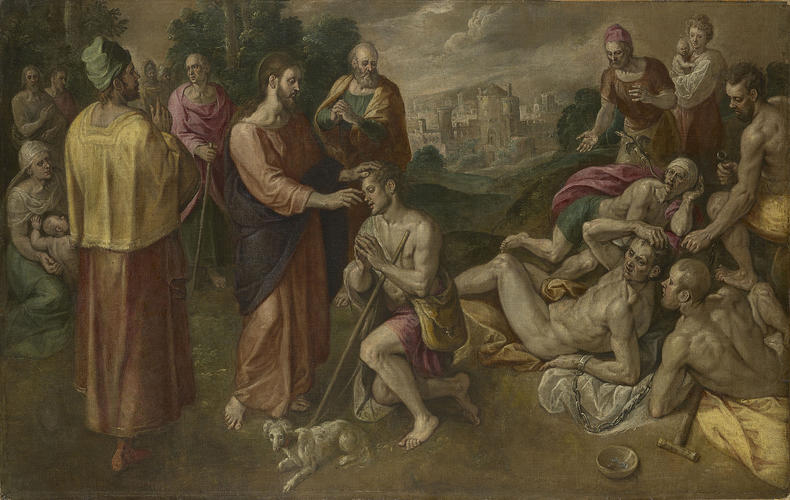Christ Healing the Sick Signed and dated 1577
Oil on canvas | 90.7 x 142.2 cm (support, canvas/panel/stretcher external) | RCIN 405524

Crispin van den Broeck (1524-91)
Christ Healing the Sick Signed and dated 1577


-
Whether the Antwerp-based artist Crispin van den Broeck ever travelled to Italy is not known for certain, but the influence of the Venetian style of Jacopo Bassano (c.1510-92) is evident in his employment of large, tangible figures set within a landscape. Having been trained by Frans Floris (c.1518/20-70), who did travel to Italy, it is possible that he was simply influenced by this Italianate master and by engravings after Italian originals, which were extremely popular at the time. Another technique that van den Broeck learnt from Floris was that of applying a brown preparatory ground underneath the main colours of his paintings, which accounts for the predominantly brown hue that characterises his works.
As well as a distinctive colour scheme focusing on pink, brown, grey and yellow tones, van den Broeck's treatment of form is striking. Here the figures are the focal point, dominating the landscape and the view of Jerusalem beyond. It was perhaps this attention to the contours of form that made his art perfectly adapted for engraving work; he supplied numerous illustrations and designs to the Antwerp engravers, providing, for example, the illustrations for Lodovico Guicciardini's 'Descrizione di tutti I Paesi Bassi' (1567).
This painting probably does not illustrate a specific story but rather conveys more generally Christ's mission to save the unfortunate and heal the sick. The figures are divided into two sections, the sound to the left and the sick to the right. Christ is opening the eyes of a blind man, who kneels at his feet, in a posture reminiscent of a man receiving baptism. His dog stares out of the painting, a reminder that soon he will no longer be needed to lead his master. Behind them stands St Peter praying, and to the left a richly dressed man, probably a Pharisee, coolly appraises the miracle. He turns his back to the viewer to lead the eye into the composition and (with the blind man) offers a perfect contrast of pride and humility.
There are three principal unfortunates: a lame beggar, with a crutch and bowl, and two mad men. One of the latter is manacled, his chain held by a keeper; the other is cured of his possession, as an evil spirit (looking rather like a winged lizard) leaves his mouth. The family beyond may be supplicants or onlookers.
There are no records to indicate the original location of this painting, but it seems likely to have been commissioned by a hospital where its theme of healing and salvation would have been appropriate.
Signed with a monogram and dated 1577
Catalogue entry adapted from Bruegel to Rubens: Masters of Flemish Painting, London, 2007Provenance
Acquired by Charles II from the collection of John Michael Wright, mid-1660s
-
Creator(s)
Previously attributed to (artist)Acquirer(s)
-
Medium and techniques
Oil on canvas
Measurements
90.7 x 142.2 cm (support, canvas/panel/stretcher external)
107.9 x 160.2 x 4.5 cm (frame, external)
Category
Object type(s)







